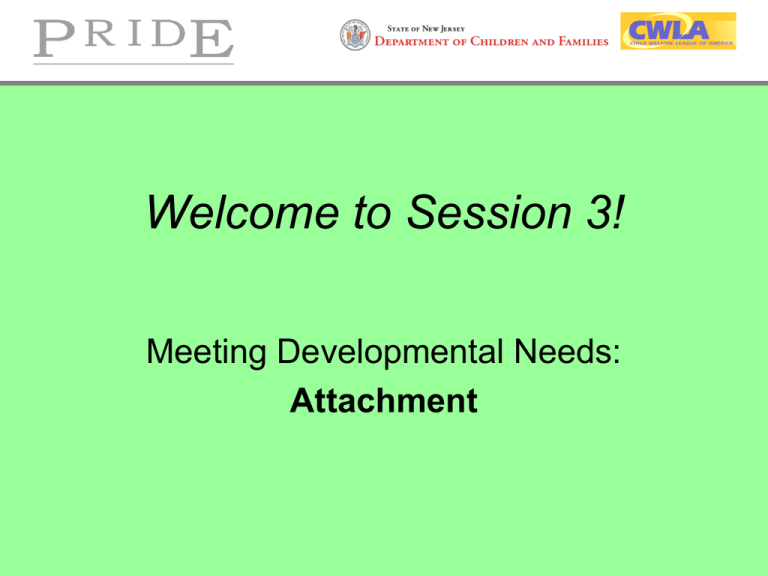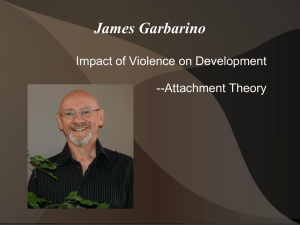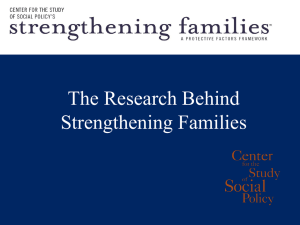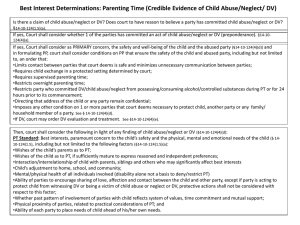
Welcome to Session 3!
Meeting Developmental Needs:
Attachment
Remember the Core Competencies of PRIDE:
1. Protecting and Nurturing Children
2. Meeting Children’s Developmental Needs
and Addressing Developmental Delays
3. Supporting Relationships Between Children
and Their Families
4. Connecting Children to Safe, Nurturing
Relationships Intended to Last a Lifetime
5. Working as a Member of a Professional Team
What did we learn about in
Session 2?
“Parking Lot”
Are there any questions from
the last session that we can
answer now?
Supplemental Handouts for This Session
• “A Child’s Needs”
• Ways to encourage attachment and build selfesteem
• Suggestions for handling drug-exposed babies
• Common “Survival” Behaviors
Influence of Family, Environment & Attachment
• Knowledge of human development is a necessary first step to
understanding the children who will be placed in your home
• Human development is a combination of genetic and environmental
factors
• Every child needs to achieve certain physical, intellectual, emotional
and social developmental tasks
• Name some examples of tasks achieved in the areas of:
–
–
–
–
Physical development
Intellectual development
Emotional development
Social development
Overview of Attachment
• Those of us who are experienced parents
understand a lot about normal human
development and attachment
• One doesn’t need to obtain advanced academic
degrees to really understand child development
• Things we do for our children on a daily basis,
meeting their basic needs, naturally develops
attachment, security and trust
• This is defined by the “Arousal-Relaxation” Cycle
(PRIDEBook p.73). Let’s just call it the
“Attachment” Cycle
The Arousal-Relaxation (Attachment) Cycle
How Attachment Develops
Child feels discomfort
(a hungry baby)
Child feels comfortable
(baby stops crying/relaxes)
Child expresses need
(baby cries)
Parent satisfies need
(feeds the baby)
The Arousal-Relaxation (Attachment) Cycle
How Attachment Develops
Child feels discomfort
(a hungry baby)
Child expresses
need
Child develops a sense
of
(baby cries)
safety, security and trust!
Child feels comfortable
(baby stops crying/relaxes)
Parent satisfies need
(feeds the baby)
Overview of Attachment – Guided Imagery
Baby “Amanda” and Baby “Ben”
• How was Ben’s ability to bond affected by his parents’
abuse and neglect?
• What were the factors that “broke” the attachment cycle?
• How will Ben overcome his delays?
Factors Leading to Developmental Delays
• There are many factors that can lead to developmental delays in
children who are involved with the child welfare system
• Name some of these factors:
– Genetic or congenital conditions (Down’s Syndrome, Cerebral Palsy,
congenital blindness or deafness)
– Prenatal factors (drug/alcohol exposure, HIV, poor nutrition)
– Physical neglect (lack of supervision, poor health care, lack of
food/shelter/clothing, lack of stimulation)
– Physical abuse
– Sexual abuse (fondling, penetration, sodomy, exposure to pornography)
– Emotional abuse (verbal belittling, name calling, shaming, isolation)
– Accidents and trauma (car accidents, falls, severe beatings, torture)
– Inappropriate behavior patterns (observation of domestic violence,
substance abuse, adult sexual activity, cruelty to others, criminal acts)
Factors Leading to Developmental Delays
• Some children may experience multiple factors that impact their
growth and development
• Adolescents have some unique developmental challenges. Can you
name some of them?
– Separation from family and developing a sense of independence
– Developing a sense of one’s sexuality or sexual identity
– Developing a career path
• The developmental challenges of teenagers can be significantly
compounded by their experiences of abuse and neglect
A Child’s Experience of Abuse and Neglect
• Over a million children per year are identified as victims of some
type of abuse or neglect
• Over a thousand of these result in fatalities
• It is important to understand the types of abuse and neglect that
children experience that are the reasons they are placed into care
• While New Jersey has its own laws that define abuse and neglect,
federal guidelines have begun to promote a reasonable consistency
from state to state
• The National Clearinghouse on Child Abuse and Neglect has
defined several major areas of abuse and neglect
(http://nccanch.acf.hhs.gov)
Definitions of Abuse and Neglect
•
•
•
Physical Abuse is physical injury (ranging from minor bruises to severe
fractures or death) as a result of punching, beating, kicking, biting, shaking,
throwing, stabbing, choking, hitting (with a hand, stick, strap, or other
object), burning, or otherwise harming a child. Such injury is considered
abuse regardless of whether the caretaker intended to hurt the child.
Sexual Abuse includes activities by a parent or caretaker such as fondling
a child's genitals, penetration, incest, rape, sodomy, indecent exposure, and
exploitation through prostitution or the production of pornographic materials.
Emotional Abuse is a pattern of behavior that impairs a child's emotional
development or sense of self-worth. This may include constant criticism,
threats, or rejection, as well as withholding love, support, or guidance.
Emotional abuse is often difficult to prove and, therefore, child welfare
agencies may not be able to intervene without evidence of harm to the child.
Emotional abuse is almost always present when other forms are identified.
Definitions of Abuse and Neglect
•
Neglect is failure to provide for a child's basic needs. Neglect may be:
– Physical Neglect (e.g., failure to provide necessary food or shelter, or lack of
appropriate supervision, etc.)
– Medical Neglect (e.g., failure to provide necessary medical, dental or mental
health treatment)
– Educational Neglect (e.g., failure to educate a child or attend to special education
needs)
– Emotional Neglect (e.g., inattention to a child's emotional needs, failure to
provide psychological care, or permitting the child to abuse substances such as
alcohol or other drugs)
•
•
These situations do not always mean a child is neglected. Sometimes
cultural values, the standards of care in the community, and poverty may be
contributing factors, indicating the family is in need of assistance.
Poverty alone does not constitute neglect, however, when a family fails to
use information and resources, and the child's health or safety is at risk,
then child welfare intervention may be required.
WARNING! Some of the language contained in this video is offensive.
Video Vignette - Annie
• What types of abuse or neglect were presented in this clip?
– Emotional maltreatment – screaming at the dinner table, trying to force
Annie to eat, calling Annie a “bitch”)
– Physical abuse – a voice says, “You’re hurting her arm.”; Annie has cuts
on her forehead)
– Sexual abuse – at the end of the video, the father comes into Annie’s
bedroom and Annie says, “Not again, Daddy.”
• Does the mother’s failure to protect Annie constitute neglect?
Examples of Maltreated Children - Vignettes
• How do you think Annie’s experiences might affect her overall
development and ability to form attachments?
–
–
–
–
Unable to trust others, especially adults
Afraid to attach to foster parents because “attachment=abuse”
Problems in school (preoccupied with problems)
Fear of taking risks (low self-esteem)
• How do you think Annie’s experiences might affect her behaviors as
she is placed in a foster home?
–
–
–
–
–
–
May be afraid to go to bed at night
May be afraid to eat meals with the family
May withdraw because she is ashamed of what has happened
May be angry and act out her anger on the family
May use inappropriate language that she has heard at home
May behave in a sexual manner beyond a normal child of her age
Impact of Abuse and Neglect on Attachment
• Child maltreatment can strongly affect a child’s ability to form
healthy attachments
• While children may survive in abusive or neglectful environments,
they do not thrive
• When thinking about a child’s attachment history, it is helpful to
consider a “continuum” that goes from less secure attachment to
more secure attachment
• It is important to understand that this describes a suggested
continuum of attachment and not specific diagnoses of attachment
disorders.
Less Secure Attachment
More Secure Attachment
Unattached - Disorganized - Ambivalent - Anxious - Healthy Attachment
Impact of Abuse and Neglect on Attachment
• An unattached child is rare because most children will have formed
an attachment to someone in their lives.
• Insecure attachment in some children who do not know how to have
their needs met leads to disorganized behaviors, such as being out
of control and having difficulty expressing or regulating their
emotions and behaviors
• Other children may exhibit ambivalence in their behaviors because
they may have been punished for expressing their needs and
learned that the best strategy for being in a relationship is to hide
needs and feelings behind a mask of detachment
• Children with anxious attachment exhibit clingy and needy behavior
because they may have been left alone frequently or may have
experienced multiple, frequent separations
• Remember Vernon from the “Making a Difference” video? Where
does he fall on the Attachment Continuum?
Vernon’s Behaviors
• Vernon was very angry when he moved in with the Hansons, even
though it was clearly a safe and nurturing environment. Why
wouldn’t Vernon be happy or relieved to get away from the
environment where he was being hurt?
– He was raised in this environment and this is all he knows or
understands. The relationship was painful, but it is familiar.
– Instead of thinking that his parents are at fault, he blames himself.
– Abusive attention may be the only attention he has received. Negative
attention may be better than no attention at all.
– Vernon’s mother loves him has not intentionally caused him harm.
Even when she was abusive or neglectful, she was not consistent in
those behaviors. Vernon probably only remembers the “good” times
that they had.
Maltreated Children and Attachment - Vignettes
• Alicia, PRIDEBook Page 75
• Kevin, PRIDEBook Page 76
• Annie, PRIDEBook Page 77
• What behaviors do each of these children exhibit that may be
difficult for the foster families to handle?
• What are some strategies that can be used to deal with these
behaviors?
• Think about where these children fall on the continuum of
attachment.
Video Vignette - Kevin
Video Vignette - Kevin
•
•
•
•
How does the video clip of Kevin make you feel?
What do you think Kevin means by, “My home, my castle?”
How do you think Kevin felt about his own identity?
What does Kevin tell us about what needs to happen within the child
welfare system?
• Don’t be discouraged by how Kevin is presented! The video
highlights the importance of working together as a team to try to
prevent children from having the negative experiences that Kevin
encountered.
Survival Behaviors
• Aggressiveness: I’ll hurt you before you can hurt me.
• Testing and Control Battles: I feel like my life is out of
control, so I’ll try to control you!
• Identity Issues: Because of my abuse/neglect, many
moves, or believing I was given away, I feel like a
nobody.
• Anger or Depression: I’m afraid to get close to you.
You may hurt me too.
• Values Issues/Lying and Stealing: What I learned from
my experiences is very different from your family. If I tell
the truth, I may be hurt. I must take what I need in order
to take care of myself.
Survival Behaviors
• Separation Anxiety: You will leave me, just like
everyone else has.
• Over-Competency: I don’t trust that you can take care
of me, so I’ll have to do it myself.
• Inappropriate Sexual Behavior: This is the only way I
know how to get close.
• Withdrawal From Relationships: I won’t relate to you.
That way, I won’t have to care about you.
• Hoarding: I think of the world as scarce, and I need to
make sure my needs will be met.
Survival Behaviors
• Hypervigilence: I believe that the world is a cruel and
hostile place and I must always be aware that the next
disappointment or painful experience is just around the
corner.
• “Wise Beyond My Years”: I have learned how to
manipulate the systems that control me.
Impact of Abuse and Neglect on Behavior
• Some children are very needy and it may be very frustrating trying to
meet their needs
• They may be slow to respond to your love and nurturing
• When children don’t trust, they can be very rejecting
• It is difficult for resource parents to feel the same type of gratification
that they may feel, or have felt, with their birth children
• The difficult behaviors displayed by children who are abused and
neglected can stir up negative feelings in caregivers
• Over time, nurturing and perseverance on the part of the caregivers
by consistently meeting the child’s needs will instill trust in these
children and enable them to form healthy attachments
Impact of Abuse and Neglect on Development
• See the chart on Pages 82-85 in the PRIDEBook, “Summary of
Stages of Child Growth and Development”
• While not all children develop at the same rate, there are general
predictions about when children should be reaching key milestones
• The influences of abuse and neglect can negatively impact the
achievement of these milestones
• It is important to note that this chart does not include any indication
of cultural development, and that as resource parents, we must
learn as much as possible about a child’s family culture before
expressing a concern to the team about a possible developmental
delay
Impact of Abuse and Neglect on Development
• Neglect
– Children who are not supervised my harm themselves, and as a result
may learn not to take risks, which can delay development.
– A child left alone cannot model or mimic the skills of their caregiver.
– Children may not have objects to play with or things to watch and
observe and they do not receive adequate stimulation.
– Basic needs must be met before children can concern themselves with
other developmental tasks. If a child is hungry, sick or craving
emotional attention, he or she cannot attend to other skills or learning.
Impact of Abuse and Neglect on Development
• Physical Abuse
– A child who is physically abused may be afraid to take risks for fear of
doing something wrong.
– Some children sustain serious injuries that affect their development on
an ongoing basis, such as hearing loss, blindness or brain injuries.
• Sexual Abuse
– The effects of sexual abuse may include factors that could impede
normal sexual development, such as exposure to sexual activity before
a child is physically mature, sexually transmitted diseases and
infections, and emotional trauma
– The emotional trauma of sexual abuse may take tremendous energy
and focus that would otherwise be devoted to age-appropriate
developmental tasks. For example, how does an 11 year old who has
been sexually abused by her uncle sit around and giggle with her
girlfriends about “cute boys” in class?
Impact of Abuse and Neglect on Development
• Emotional Maltreatment
– A child’s self-esteem may be seriously eroded to the point where the
child feels incompetent to tackle even basic life skills.
– When a child is prevented from developing outside relationships may
result in poor social development, lack of social skills, or difficulty with
peers
Impact of Abuse and Neglect on Development
• Consider the various aspects of a child’s development as they relate
to the child’s age for a “normal” 8-year old child:
–
–
–
–
–
–
–
–
Chronological Age
Physical Appearance
Intellectual Age
School Age
Emotional Age
Social Age
Culture, Ethnic, Religious Experiences
Life Experiences
8
8
8
8
8
8
8
8
Impact of Abuse and Neglect on Development
• Now consider the same scenario for Vernon from the “Making A
Difference” video, who was subjected to abuse and neglect and
resides in a foster home, separated from his birth family:
–
–
–
–
–
–
–
–
Chronological Age
Physical Appearance (may look a bit younger)
Intellectual Age (no obvious concerns)
School Age (below grade level)
Emotional Age (lack of trust, emotional outbursts)
Social Age (doesn’t get along well with peers)
Culture, Ethnic, Religious Experiences
Life Experiences (has experienced more than most of his peers)
8
7
8
6
1-2
2-3
(unclear)
17-18
Impact of Abuse and Neglect on Development
• How can we help equalize things for Vernon?
–
–
–
–
–
–
Be the child-loving family that we are!
Meet his everyday needs
Empower him to make good decisions
Encourage age-appropriate activities (playing, sports, books, TV)
Work with school professionals to get his education on track
Work with other team members (caseworker, school staff, birth father,
counselor) to bolster his self-esteem
– Get involved in religious community
“Parking Lot”
Are there any questions that you had
that may not have been answered
during this session?
Let’s add them to our Parking Lot!
CLOSURE
• Review Key Points, PRIDEBook Pages 100-109
• Review You Need to Know!, PRIDEBook Pages 110-126
– Pay extra attention to p. 117
• Read A Birth Parent’s Perspective, PRIDEBook p. 127
• Complete the PRIDE Connection exercises on
PRIDEBook Pages 128 and 129 (copy in packet)
• Read Making A Difference!, PRIDEBook Page 130
• Session 4: Meeting Developmental Needs: Loss








